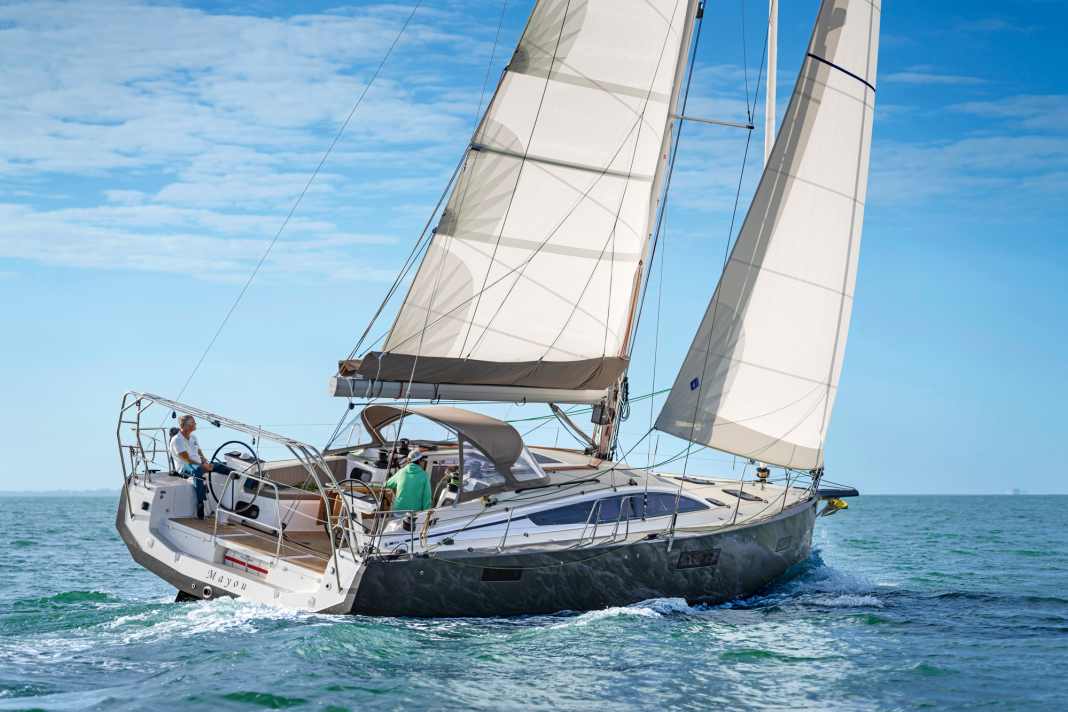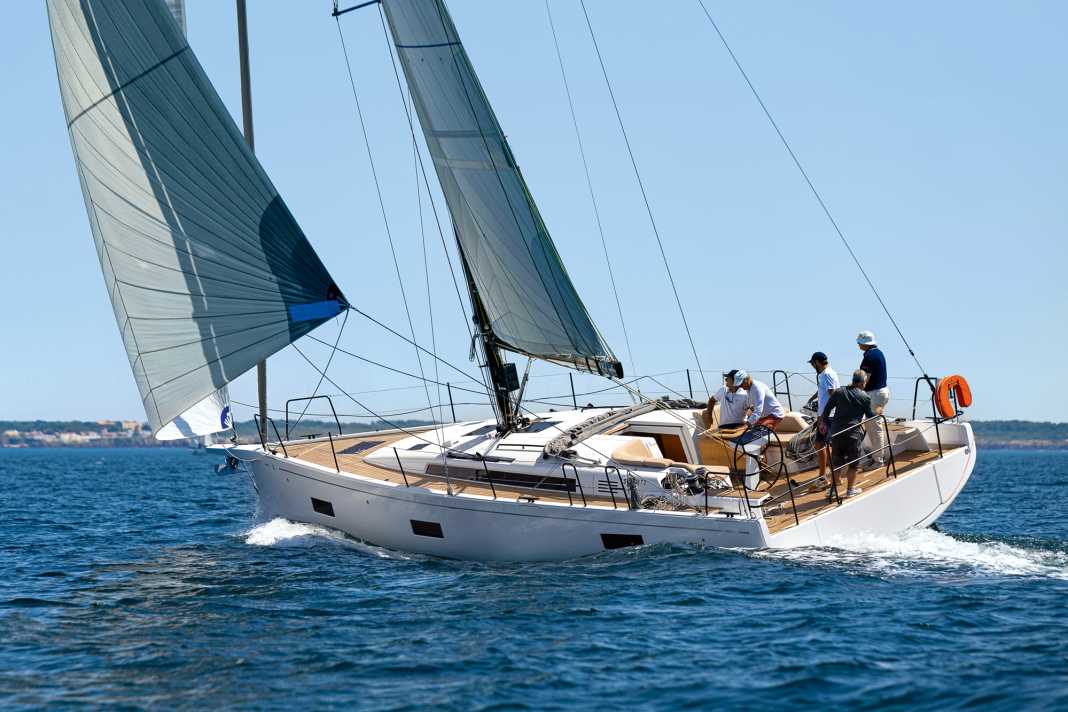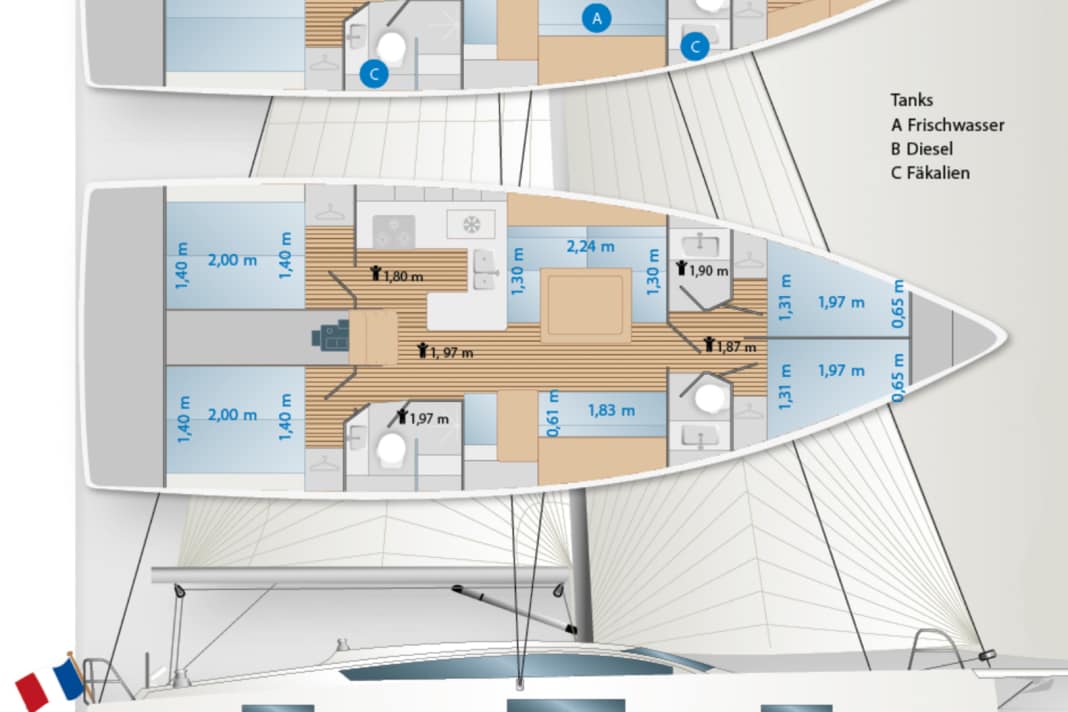





Strong number for individualists
There are not many manufacturers on the market that have remained as true to their individual brand values over the years as the RM Yachts shipyard. Since 1989, the busy yacht builders in La Rochelle have been producing ocean-going sailing yachts made of GRP and plywood in a length segment between 30 and almost 50 feet. As if this alone were not special enough, the French have never really wanted to orientate themselves to the current zeitgeist, but have always and unconditionally stuck to their special concept - seemingly regardless of how the general trends are developing. An RM should be incomparable and unrivalled on the market - that is the most important corporate philosophy.
Nevertheless, the RM Yachts shipyard got into financial difficulties in 2019 and even had to file for insolvency. The debt burden was no longer sustainable for the medium-sized company. The rescue came at the beginning of 2020 with the takeover of the RM brand by the powerful Grand Large Yachting Group (Allures, Garcia, Outremer, Gunboat). With this strong merger behind it and a new management team, RM was able to rebuild itself and take off again with a newly developed flagship RM 1380.
Unique combination of wooden hull and GRP deck
For the construction of the hulls, plywood panels delivered to RM Yachts ready-made are fitted together over a Mallen template, laminated over at the joints and the body coated with epoxy. The finished hull is then coated again with epoxy resin and reinforced on the inside in the area of the keel mounts with galvanised steel frames. In this way, RM achieves a strong bond with high rigidity. The stringers and floor skirts are also made of plywood and laminated, as is the entire interior. However, plywood is not suitable as a construction material for the complicated, angled structures of the deck. That is why RM Yachts builds the decks of all current yachts as a GRP sandwich construction using the vacuum infusion process. The combination of wooden hull and GRP deck is unique in series yacht construction worldwide.
The buckling frame is inevitably associated with this construction method. Plywood can only be bent into shape to a limited extent, which inevitably leaves hard edges in the hull. Years ago, RM's multi-buckling bulkheads therefore stood out visually and were considered exotic. Today, as the pronounced and elongated chine edges have become an integral part of the series, even on pure GRP cruising yachts, the angular RM hulls are less conspicuous. What's more, the radical design language seems more contemporary than ever. The disadvantage of the plywood hull: despite a lot of filling and sanding work, the outer skin often remains somewhat wavy, which is particularly noticeable on the dark painted surfaces.
Various keel variants are available for the RM 1380
As with all other boats from the RM brand, customers can choose between different keel variants for the new flagship model. The boat is delivered with two bilge keels as standard - one of RM's many specialities. This emphasises the shipyard's claim of high blue water suitability with the option of allowing the boat to dry out in tidal waters and with the help of mudflats - regularly if necessary.
Alternatively, the shipyard also builds the boat with an electro-hydraulically retractable swing keel and an impressive draught variation of 1.45 to a maximum of 3.35 metres. A fixed keel in a sporty T-shape with ballast bomb is also possible. However, this option is rarely ordered from RM.
During the test run under sail, our test boat, construction number three, with chine keels and two rudder blades, shows an all-round solid performance with a high fun factor. In winds between 12 and 15 knots, the potential is easy to realise. At cruising speed, the large ship, which is not particularly light at just under ten tonnes, manages 7.2 knots. A good value for a cruising yacht of this size. However, there is also a lack of height in the wind during the test, which is not unusual for boats with chine keels. The tacking angle with the large genoa is at least 90 degrees. According to the designers' polar data, the boat should be able to run at least five degrees higher with a swing or fixed keel.
RM 1380 has sporting potential
The standard rig comes from the manufacturer Z Spars and is equipped with strikingly long and also extremely strongly swept spreaders. This allows a greater overlap of the genoa (maximum 112 per cent), which can be particularly beneficial in light winds. For long strokes, the option of a smaller staysail, a so-called trinquette, is recommended. However, additional backstays must be attached to stabilise the mast in swell. A jib with a self-tacking device is not an alternative, not least because of the huge RM-typical panoramic window in the superstructure in front of the mast.
For the layout in the cockpit, the shipyard continues to rely on the tried-and-tested concept typical of the brand. This means that the halyards and trim lines run back over the cabin superstructure to the two winches on the companionway. Two winches are available for the genoa and gennaker sheets, set back slightly and lower down. They are mounted on separate platforms and can be operated very efficiently at a good height and close to the body while standing.
The mainsheet is a German Cupper system, which is continuously deflected aft on both sides over the mast foot to two large winches on the aft coaming. These can be easily reached by crew members from the cockpit as well as by the helmsman from his working position behind the wheel.
Moreover, the high-quality deck fittings from the renowned manufacturers Harken and Antal and the pleasingly large standard winches ensure smooth manoeuvres.
The RM 1380's competition: stylish and fast too





There is a lack of ventilation below deck
RM also uses plywood almost exclusively for the interior fittings. However, the fixtures are not covered with real wood veneers, as is usually the case in series production, but are meticulously levelled and coated with paint. The surfaces are simply perfect. The customer has a free choice of colours in combination with the numerous variants for the upholstery and floorboards. This offers a high degree of visual individuality. In the test boat, the snow-white colours predominate, both for the furniture and the fabrics. This has a very pleasant effect at first glance and creates an almost Mediterranean living atmosphere in the spacious, loft-like saloon.
In addition, the interior surprises with an unusually large amount of light thanks to the large window areas in the cabin superstructure and in the hull and, above all, the large panoramic window in front of the mast, through which you can also look forward in the direction of travel from inside. Nevertheless, there is a lack of effective ventilation options below deck in general and in the saloon in particular.
Cabin layout can be modified on request
The interior design is standard with a large owner's cabin in the foredeck and a functionally separate bathroom. This means that the toilet and washroom with shower are housed separately in two smaller wet areas to the side, which is very convenient for use on a long tour. The almost completely free-standing, rectangular island bed in the foredeck offers good access, but with a continuous width of just 1.33 metres, it is quite narrow for two people. On request and for use in yacht charters, the shipyard can also divide the foredeck lengthways to create two cabins, each with its own bathroom.
Aft, the layout remains symmetrical with two double cabins. The berths here are also rectangular and, with a width of 1.40 metres, just meet the minimum comfort requirements for two. To achieve this, RM has built a very generous technical duct in the centre between the rear cabins, which also acoustically decouples the two areas. With a width of 73 centimetres, the tunnel is large enough for many technical installations such as a generator, a water maker or additional tanks for fresh water or fuel.
High price, but high performance in return
The price tag for the RM 1380 is just under 480,000 euros, which is not a small amount of money for a 44-footer by comparison. However, it is important to differentiate once again, as the RM comes from the shipyard with a particularly high standard of construction, fittings and equipment. What's more, the basic price also includes a simple set of standard Dacron sails. RM can also offer a level of customisation that many customers want and cannot get elsewhere. The independent concept and the unusual design are inspiring.
The measured values for the RM 1380 test





The RM 1380 in detail



Technical data of the RM 1380
- Design engineer: Marc Lombard Design Group
- CE design category: A
- Torso length: 13,30 m
- Total length: 14,40 m
- Waterline length: 12,39 m
- Width: 4,53 m
- Draught chine keels: 1,95 m
- Draught Swivelling keel: 1,45-3,35 m
- Mast height above WL: 20,50 m
- Theor. torso speed: 8.6 kn
- Weight: 9,8 t
- Ballast/proportion: 2,87 t/30 %
- Mainsail: 58,0 m²
- Furling genoa (112 %): 57,0 m²
- machine (Volvo P.): 44 kW/60 hp
- Fuel tanks (PVC): 2x 150 litres
- Fresh water tanks (PVC): 2x 135 litres
- Holding tanks (PVC): 3x 55 litres
Hull and deck construction
Hull: Plywood (Okoume) in multi-buckling frame with epoxy coating. Deck: GRP sandwich
Price and shipyard
- Base price ex shipyard: 477.740 €
- Standard equipment included: Sail (main and genoa), engine, sheets, railing, navigation lights, battery, compass, cushions, galley, bilge pump, toilet, fire extinguisher, electric cooler, waste-holding tank with suction system
- For an extra charge: Sail dress (lazy bags) €2,350, mooring kit (anchor with chain/fender/mooring) €2,185, antifouling paint €1,700, clear sailing handover €7,975
- Price ready to sail: 491.950 €
- Guarantee: 2 years
Surcharge for comfort equipment
- Hole points: incl.
- Traveller with line guide: incl.
- Electric windlass: incl.
- Tube kicker: incl.
- Backstay tensioner: incl.
- Jumping cleats: incl.
- Sprayhood: 3.580 €
- Teak in the cockpit (synth.): 8.535 €
- VHF radio: E-package
- Log and echo sounder: E-package
- Wind measuring system: E-package
- Autopilot: E-package
- Electronics package: 15.710 €
- Charger: incl.
- Electrical package: incl.
- Shore connection with RCD: incl.
- 230 volt socket (one): incl.
- 12-volt socket in sat nav: incl.
- Heating: 13.100 €
- Pressurised water system: incl.
- Hot water boiler: incl.
- Shower WC room: incl.
- Cockpit shower: incl.
Comfort price: 532.875 €
Included in the price: Bowsprit with anchor bracket, swim ladder, storage compartment for life raft
As of 01/2024, how the prices shown are defined can be found here!
Sail
The mainsail with three reefing tracks and the furling genoa with UV protection (both Dacron) are included ex shipyard. Stag jib, gennaker or code zero optional
Rig
Aluminium mast and main boom from the manufacturer Z Spars with wire shrouds (1:19). Cutter stay with backstays possible. Carbon fibre rig from Z Spars with Dyform shrouds as an extra (surcharge approx. € 51,500)
Motorisation
Built-in diesel Volvo Penta D2-60 with Saildrive propulsion and 2-blade fixed pitch propeller. Possible upgrade: Volvo Penta D2-75 (55 kW/75 hp)
Winches
2x Harken 55 Radial STA for the genoa sheets, 2x Harken 45 STA for halyards and trim lines
YACHT rating of the RM 1380
Attractive mix of superior blue water suitability and sporty sailing characteristics. The design with plywood hull and GRP deck is just as unique as the rest of the boat. Different keel variants are available
Design and concept
- + Wide range of applications
- + Durable construction
- + Several keel variants
- - Hull outer skin partly uneven
Sailing performance and trim
- + High performance potential
- + Agile sailing characteristics
- - Only partially suitable for one-handed use
- - Very little rudder pressure
Living and finishing quality
- + Impeccable light-coloured finish
- + Large window areas
- - Narrow island bed in the foredeck
- - Missing handrails in the lounge
Equipment and technology
- + Easily accessible controls
- + Lots of storage space on deck
- + Optimum winch positions
- - Few ventilation options
Shipyard
RM Yachts, 17185 Périgny; www.rm-yachts.com
Distribution
Blue Yachting, D-28237 Bremen; www.blue-yachting.de

